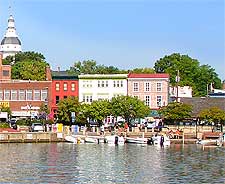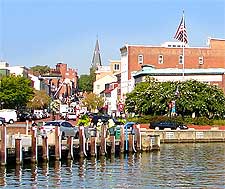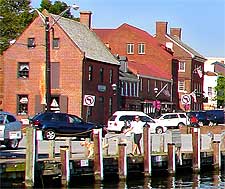Annapolis History Facts and Timeline
(Annapolis, Maryland - MD, USA)

Originally a Puritan settlement manned by religious exiles from neighboring Virginia, Maryland's Annapolis was first established in 1649 on the north bank of the River Severn. It was relocated later to a safer harbor along Chesapeake Bay's south shore. Its considerable wealth was maintained by its position in Annapolis history as a slave-trading center until the American Civil War (1861 to 1865).
British Parliamentary forces, known as Roundheads, assumed control of Maryland in 1654, holding it for three years following the end of the Third English Civil War. This event saw William Stone, Maryland governor since 1648, exiled. His attempts to retake the region with a Cavalier force at the Battle of the Severn one year later failed and a governor sympathetic to the Roundhead cause, Josiah Fendall, was raised to office. After the final defeat of the Roundheads in England and the restoration of the monarchy under King Charles II, Fendall was replaced by monarchist Philip Calvert. In 1694 the town of Annapolis was bestowed its present-day name after Anne of Denmark, future Queen of England.

18th Century Wealth and Culture
By the middle of the 18th century, Annapolis was a byword for elegant, cultivated society and extreme wealth. During this point in Annapolis history, the weekly Maryland Gazette, devoted to the comings and goings of the city's luminaries, was founded, and a theater opened in 1769. Commerce ruled the economy through the city's port until Baltimore's deep harbor opened and took most of the shipping trade, leaving the city to rely on sail making, boat building and the packing and shipping of the oyster harvest.
Temporary Fame and the Civil War
After the 1783 Treaty of Paris ended the American Revolutionary War, Annapolis briefly became the first peacetime capital city of the United States for a period of one year. By 1861, the country was at civil war, with Annapolis the site of a huge prisoner of war camp on its western outskirts, and home to a major hospital serving wounded troops from both the Union and Confederate armies.

20th Century to the Present Day
By the turn of the 20th century, the population of Annapolis had reached almost 8,000, a small number by comparison with the massive growth during the last half of the 19th century of numerous other American cities. Many of its grand buildings have survived, some from the 17th century but most from the 18th century, and can still be seen nowadays. Among the grandest buildings are those of the United States Naval Academy, founded in 1845 and today protected as a National Historic Landmark.
Another brief moment of fame in Annapolis history was when Alex Haley's book 'Roots: The Saga of an American Family' was published in 1976. The book tells the tale of his ancestor, Kunta Kinte, captured in Africa and brought to Annapolis to be sold as a slave on one of the notorious slave ships. Today, a monument to both Haley and his ancestor can be seen on the harbor, at the spot where Kunta Kinte first set foot in America.
 Originally a Puritan settlement manned by religious exiles from neighboring Virginia, Maryland's Annapolis was first established in 1649 on the north bank of the River Severn. It was relocated later to a safer harbor along Chesapeake Bay's south shore. Its considerable wealth was maintained by its position in Annapolis history as a slave-trading center until the American Civil War (1861 to 1865).
Originally a Puritan settlement manned by religious exiles from neighboring Virginia, Maryland's Annapolis was first established in 1649 on the north bank of the River Severn. It was relocated later to a safer harbor along Chesapeake Bay's south shore. Its considerable wealth was maintained by its position in Annapolis history as a slave-trading center until the American Civil War (1861 to 1865).
